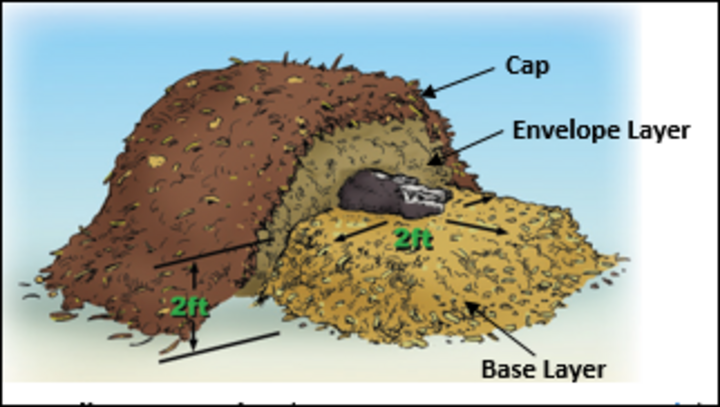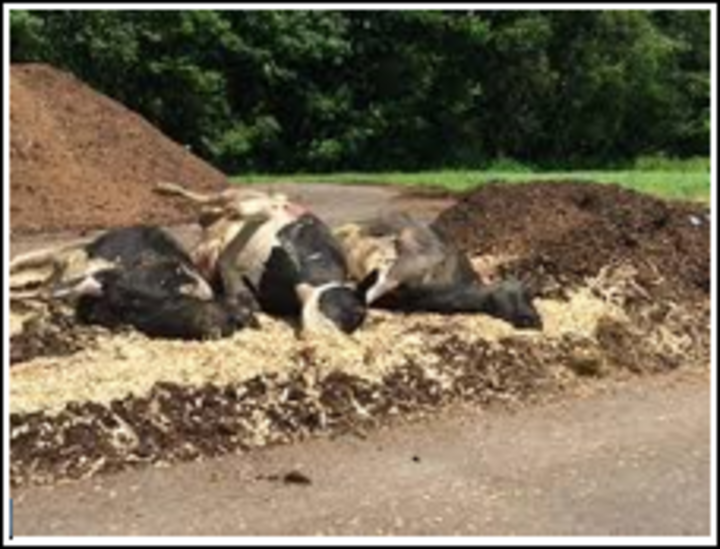Emergency Disposal of Livestock Carcasses
This guidance applies to emergency disposal of livestock carcasses resulting from extreme weather events.
It is not intended to be used for routine mortality management or disease-related livestock losses.
Five methods are approved for the routine disposal of livestock carcasses in Nebraska: composting, burial, incineration, rendering and land-filling. In an emergency situation – such as when livestock losses occur due to extreme weather or another non-disease related event – these five options still exist, but may not be suitable in all situations. The feasibility of carcass disposal via incineration, rendering or land-filling will depend on existing infrastructure or resources and, therefore, will not be discussed here. Acceptable processes for emergency composting and burial of livestock carcasses are described here.
Executive Order No. 19-03 (March 20, 2019) provides farmers and ranchers a “reasonable amount of time” to dispose of deceased livestock due to severe weather and flooding. This order supersedes the existing State of Nebraska regulation requiring mortality disposal within 36 hours of learning of the death of the animal.
COMPOSTING
In an emergency situation, composting may be the most suitable carcass disposal option. This is particularly true if the ground is frozen (preventing burial), saturated (preventing access to move carcasses), or if existing off-farm disposal services are not available. Two methods of composting are described here: In-place Composting and Windrow Composting.
In-place Composting. If livestock carcasses are dispersed – such as in a pasture-based system – or conditions otherwise prevent the movement of individual carcasses (including frozen carcasses) to a central location for group composting, a compost pile can be built around an individual animal, allowing for “in-place composting”.
Follow these steps to construct an in-place compost pile.

- If the animal can be moved even a very short distance, place at least 24” of carbon material on the ground as a base layer and then place the animal on the base layer. This should be large enough in area to accommodate the carcass and still provide at least 24” of space between the animal and outside edges of the base layer. If the animal is frozen or otherwise cannot be moved, proceed to step 2 without constructing the base layer.
- Puncture the abdominal cavity of the animal carcass to prevent bloating and rupture during decomposition.
- Cover the animal with 24 to 36” of moist carbon material (chopped forages or corn stalks, spoiled/wet feed, wood chips/shavings, etc.) on all sides to create an envelope layer. The appropriate amount of moisture will result in the material having a “wet sponge” feel; the material should clump when squeezed in the hand but should not drip water. Any combination of available carbon materials can be used. If sufficient carbon material is not available, an alternative is to use solid manure with or without carbon material for the envelope layer. Regardless of the material used to construct the envelope layer, it is important to provide at least 24” of coverage for all parts of the animal to minimize scavenging and odor production.
- Finally, a cap should be placed on the pile to minimize odors and insulate the pile against heat loss. This cap should be comprised of 12 to 24” of carbon material (preferably dry) covering the entire pile. This cap is particularly important if manure is used in the envelope layer, to minimize odors. (NOTE: Soil can be used as pile cover material when other options do not exist; however, “sealing” a pile too well with soil can impede air flow within the pile and negatively impact the composting process. Therefore, only a thin layer of soil – perhaps 4 to 6 inches – should be used when needed to provide insulation or to hold carbon material in place under windy conditions.)
Windrow Composting. If multiple carcasses can be moved to a central location, a windrow compost pile can be used. A windrow simply allows multiple carcasses to be placed in a row within a single compost pile.

Follow these steps to construct the compost windrow.
- Place at least 24” of carbon material on the ground as a base layer. This base layer should be large enough in area to accommodate placing carcasses along the length of the pile and still provide at least 24”of space between the animals and outside edges of the base layer.
- Place animals along the center line of the pile, overlapping carcasses as much as possible while still maintaining a single layer.
- Puncture the abdominal cavities of the carcasses to prevent bloating and rupture during decomposition.
- Cover the animals with 24 to 36” of moist carbon material on all sides to create an envelope layer. (See details in step 3 of “steps to construct an in-place compost pile”.)
- Finally, a cap should be placed on the pile to minimize odors and insulate the pile against heat loss. (See details in step 3 of “steps to construct an in-place compost pile”.)
Other Composting Considerations.
- Storm water should be diverted from the compost pile(s), ponding should be minimized, and liquid leaching from the pile(s) should be contained to prevent nutrient runoff.
- No part of an animal should protrude from the pile, or odors and scavenging animals will likely be an issue.
- Carbon materials can be ground in a TMR mixer and distributed to create the base layer and/or cap for a compost pile.
- One round bale will provide about 100 cubic feet of carbon material. For a single 1,000-pound animal, about four bales will be needed to form the base layer and cap when constructing an in-place compost pile. Slightly less material will be needed per animal in a windrow due to overlapping of carcasses.
- If added moisture is needed for the material in the envelope layer, runoff holding pond effluent can be used. Care should be taken not to produce runoff from the pile area (i.e. this should not be used to dispose of a large volume of holding pond effluent)!
- Once established, piles should remain in place for at least 90 days, after which they can be turned or mixed and allowed to experience a second heating cycle.
- Any bones remaining after composting may be buried or disposed of with normal trash.
- Finished compost should be land-applied according to a nutrient management plan.
BURIAL

Recommended practices for burial of livestock carcasses during an emergency event include:
- Avoid burial within 5 feet of ground water. This is an absolute minimum! If another disposal option is possible (e.g. composting), burial should be avoided where the ground is saturated or the depth to ground water is minimal.
- Prepare the burial pit to provide sufficient depth to place carcasses in a single layer, if possible.
- If available, carbon material can be placed in the bottom of the burial pit (ideally to a depth of 24 inches) prior to placing carcasses in the pit to provide some capacity to absorb liquid.
- The top of the carcass layer in the burial pit should be at least 4 feet below the natural ground surface.
- Mound soil above the natural grade when covering the pit to allow for settling while still maintaining a slope that sheds water away from the pit.
- Avoid locating a burial pit within 300 feet of water bodies or roads; within 500 feet of domestic wells, residences, neighboring properties, and secondary highways; and within 1,000 feet of public water supply wells and primary highways. Burial is not recommended in well-head protection areas.
This article was reviewed by Larry Howard, Rick Koelsch, Leslie Johnson, Todd Whitney, Nebraska Extension